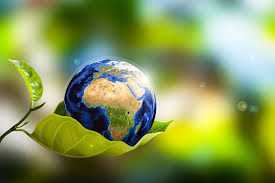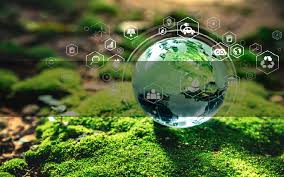Impacts of Environmental technology
Impacts of Environmental Technology: A Path Toward Sustainable Development
Impacts of Environmental technology, often referred to as “clean technology” or “green technology,” encompasses a broad range of innovations aimed at conserving the natural environment and reducing the negative impacts of human activity. As the world faces growing challenges related to climate change, pollution, and resource depletion, environmental technologies have emerged as critical tools in promoting sustainability, improving quality of life, and fostering economic development.

1. Reduction of Pollution
One of the most significant impacts of environmental technology is its ability to reduce pollution. Innovations such as air and water purification systems, waste treatment facilities, and emissions control technologies have significantly improved the health of ecosystems and communities. For example, catalytic converters in vehicles and scrubbers in industrial smokestacks help to reduce harmful emissions, leading to cleaner air and decreased incidence of respiratory illnesses.
2. Energy Efficiency and Renewable Energy
Impacts of Environmental technologies play a vital role in transitioning from fossil fuels to cleaner energy sources. Solar panels, wind turbines, geothermal systems, and hydroelectric power are all examples of renewable energy technologies that generate electricity with minimal environmental impact. Additionally, advancements in energy efficiency—such as LED lighting, smart thermostats, and energy-efficient appliances—reduce overall energy consumption and lower greenhouse gas emissions.
3. Waste Management and Recycling
Impacts of Technologies that improve waste management have led to higher recycling rates and better disposal methods. Automated sorting systems, composting technologies, and waste-to-energy plants help divert waste from landfills, recover valuable materials, and generate energy. These innovations not only reduce environmental harm but also create economic opportunities through resource recovery and green jobs.
4. Water Conservation and Management
Impacts of Environmental technology has transformed the way water is used and conserved. Innovations like drip irrigation, desalination plants, and water recycling systems help manage water resources more efficiently, especially in regions facing water scarcity. Smart water meters and leak detection technologies also aid in reducing waste and improving infrastructure reliability.
5. Climate Change Mitigation
By promoting cleaner energy sources and enhancing resource efficiency, environmental technologies contribute to mitigating climate change. Carbon capture and storage (CCS) systems, reforestation technologies using drones, and advanced climate modeling tools all support efforts to understand and reduce humanity’s carbon footprint. These technologies are crucial in meeting international climate goals such as those set by the Paris Agreement.
6. Economic and Social Benefits
Impacts of Environmental technology stimulates economic growth by creating new industries and job opportunities. The clean tech sector, including renewable energy and energy efficiency services, has become one of the fastest-growing job markets globally. Additionally, access to clean air, water, and energy improves public health, education, and overall quality of life, particularly in underdeveloped regions.https://digitalraw.in/
7. Challenges and Future Outlook
Despite its many benefits, impacts of environmental technology faces challenges such as high initial costs, resistance to change, and technological barriers in developing countries. To fully realize its potential, there needs to be continued investment in research and development, supportive policy frameworks, and international cooperation.

Negative Environmental Impacts of Environmental Technology
-
Resource Depletion
-
Manufacturing electronic devices and infrastructure often requires rare earth metals, fossil fuels, and water, leading to over extraction and habitat disruption.
-
-
Pollution
-
Air Pollution: Industrial processes and transportation emit greenhouse gases and pollutants.
-
Water Pollution: Improper disposal of waste and chemicals from factories can contaminate water sources.
-
Soil Pollution: E-waste and industrial waste can degrade soil quality.
-
-
E-Waste
-
Rapid obsolescence of gadgets leads to growing volumes of electronic waste, which is toxic and difficult to recycle.
-
-
Energy Consumption
-
Many technologies, especially in data centers and industrial processes, consume large amounts of electricity, often generated from non-renewable sources.
-
-
Climate Change
-
Technologies that rely on fossil fuels contribute to global warming by releasing carbon dioxide and methane.
-
-
Loss of Biodiversity
-
Technological development (e.g., mining, urbanization, deforestation) can destroy habitats and lead to species extinction.

-
Positive Environmental Impacts of Environmental Technology
-
Pollution Control
-
Air and water purification systems, waste treatment plants, and emissions filters reduce harmful outputs.
-
-
Clean and Renewable Energy
-
Solar panels, wind turbines, and hydroelectric dams reduce reliance on fossil fuels and lower emissions.
-
-
Energy Efficiency
-
Smart appliances, LED lighting, and building automation reduce energy use and emissions.
-
-
Conservation and Monitoring
-
Satellite imaging, drones, and sensors help monitor deforestation, wildlife, and climate changes for better management.
-
-
Sustainable Agriculture
-
Precision farming technologies reduce pesticide use and water consumption while increasing yields.
-
-
Circular Economy and Recycling Tech
-
Technologies that enable material reuse and recycling help reduce waste and the need for raw materials.

-
Impacts of Environmental Technology: Innovating for a Greener Future
Impacts of Environmental technology, also known as green technology or clean tech, refers to the development and application of products, processes, and services that conserve natural resources, reduce environmental harm, and promote sustainable development. As global concerns over climate change, pollution, and resource scarcity grow,Impacts of Environmental technology plays a critical role in reshaping how humans interact with the planet.
What is Impacts of Environmental Technology?
Impacts of Environmental technology encompasses a wide range of solutions aimed at reducing environmental impact. These include:http://destinyds.in/
-
Renewable energy (e.g., solar, wind, geothermal)
-
Waste management (e.g., recycling, composting, waste-to-energy)
-
Water treatment and conservation (e.g., desalination, wastewater recycling)
-
Air purification systems
-
Carbon capture and storage
-
Green building technologies
-
Sustainable transportation (e.g., electric vehicles)
Key Benefits
-
Reduction of Pollution:
Impacts of Environmental technology helps decrease air, water, and soil pollution through advanced treatment and monitoring systems. -
Climate Change Mitigation:
By promoting low-carbon energy sources and carbon capture, it supports efforts to reduce global greenhouse gas emissions. -
Resource Efficiency:
Technologies such as smart grids, efficient irrigation, and circular economy innovations help optimize resource use. -
Biodiversity Protection:
Conservation technologies monitor ecosystems and help prevent habitat loss and species extinction. -
Public Health Improvement:
Cleaner environments lead to better health outcomes, especially in urban and industrial areas.
Challenges in Implementation
While environmental technologies offer immense promise, several challenges remain:
-
High initial costs for research, development, and infrastructure
-
Policy and regulatory barriers
-
Technology transfer limitations in developing countries
-
Resistance to change from traditional industries
The Future of Environmental Technology
Innovation continues to accelerate, with breakthroughs in AI-driven environmental monitoring, advanced materials for energy storage, and biotechnology for pollution cleanup (bioremediation). Governments, businesses, and communities are increasingly investing in green tech to achieve net-zero emissions goals and support the United Nations Sustainable Development Goals (SDGs).

Major Impacts of Environmental Issues:
- Climate Change:
- Rising global temperatures
- Melting glaciers and rising sea levels
- More frequent and intense natural disasters (hurricanes, wildfires, droughts)
- Air Pollution:
- Respiratory illnesses (e.g., asthma, bronchitis)
- Premature deaths from poor air quality
- Acid rain damaging ecosystems and buildings
- Water Pollution:
- Contaminated drinking water
- Harm to aquatic life and ecosystems
- Economic loss in fishing and tourism industries
- Deforestation:
- Loss of biodiversity
- Disruption of carbon and water cycles
- Increased soil erosion
- Biodiversity Loss:
- Ecosystem imbalance
- Collapse of food chains
- Reduced resilience to environmental changes
- Soil Degradation:
- Lower agricultural productivity
- Desertification
- Increased vulnerability to floods
- Waste and Plastic Pollution:
- Harm to marine life
- Microplastics entering the food chain
- Land and ocean pollution affecting aesthetics and health
Negative Environmental Impacts of AI:
-
High Energy Consumption:
-
Training large AI models (like GPT or deep neural networks) can consume massive amounts of electricity—sometimes equivalent to the annual usage of hundreds of homes.
-
Data centers that run AI systems need cooling and maintenance, adding to carbon emissions if powered by fossil fuels.
-
-
E-Waste Generation:
-
AI relies on high-performance hardware (GPUs, TPUs), which contributes to electronic waste as technology rapidly evolves.
-
-
Water Usage:
-
Cooling systems in data centers often use large amounts of water, impacting local water supplies.

-
Positive Impacts of Environmental Technology Impacts of AI:
Climate Modeling and Prediction:
-
-
-
-
-
-
AI helps scientists better understand climate patterns, extreme weather events, and sea level rise through advanced simulations.
-
-
-
-
-
Energy Efficiency:
-
-
-
-
-
-
Smart grids and AI-optimized energy systems reduce electricity waste and improve the use of renewable sources.
-
-
-
-
-
Wildlife and Forest Monitoring:
-
-
-
-
-
-
AI-powered drones and sensors help track endangered species and detect illegal logging or poaching in real time.
-
-
-
-
-
Pollution Reduction:
-
-
-
-
-
-
AI improves waste management systems, predicts pollution trends, and helps industries cut emissions through optimized processes.
-
-
-
-
-
1. Energy Production
-
Resources Used: Coal, oil, natural gas, sunlight, wind, water (hydro)
-
Use: Generating electricity and fuel for homes, industries, and transportation

2. Building Materials
-
Resources Used: Wood, stone, clay, sand, metals (iron, copper)
-
Use: Construction of homes, infrastructure, and furniture
3. Transportation
-
Resources Used: Petroleum (for fuel), metals (for vehicle parts)
-
Use: Cars, airplanes, ships, and trains rely on natural resources for fuel and construction
4. Food and Agriculture
-
Resources Used: Soil, water, sunlight, fossil fuels (for equipment and transport)
-
Use: Growing crops, raising livestock, and producing food
5. Drinking and Sanitation
-
Resources Used: Freshwater (from rivers, lakes, aquifers)
-
Use: Clean water for drinking, cooking, bathing, and hygiene
6. Manufacturing and Industry
-
Resources Used: Minerals, metals, fossil fuels
-
Use: Producing goods, electronics, tools, and machines
7. Medicine and Healthcare
-
Resources Used: Plants, minerals, fossil-based chemicals
-
Use: Producing drugs, medical devices, and natural remedies
8. Clothing and Textiles
-
Resources Used: Cotton, wool, flax, synthetic fibers from petroleum
-
Use: Making clothes, fabrics, and footwear
9. Technology and Electronics
-
Resources Used: Rare earth metals, copper, silicon
-
Use: Manufacturing smartphones, computers, and batteries
10. Recreation and Cultural Use
-
-
-
-
-
-
-
Resources Used: Forests, rivers, landscapes, wildlife
-
Use: National parks, tourism, cultural practices, and relaxation
-
-
-
-
-
-


